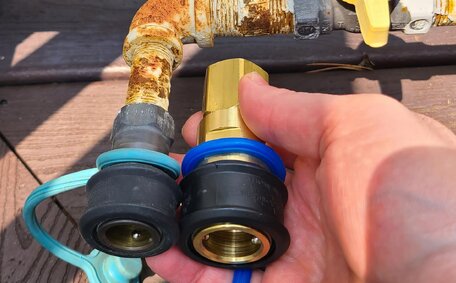Understanding Why You Might Need to Move Your Gas Meter
There are several reasons you might consider moving your gas meter:
- Home renovations or extensions - Upgrading appliances or altering your home’s layout can make relocating your gas meter essential.
- Safety concerns - Relocating your gas meter is crucial if located in high-risk areas, such as near a driveway with regular vehicle traffic.
- Aesthetic preferences - You may prefer a less conspicuous location for your gas meter to improve your home’s aesthetic.
- Non-compliance issues - To comply with safety regulations, gas meters must be positioned at least one metre away from potential ignition sources. If non-compliant, relocation is mandatory.
Gladesville Plumbing specialists can evaluate the necessity of moving your meter and identify the optimal location for it in your new layout. We offer personalised advice on relocating your gas meter, ensuring the process fits your specific circumstances. Contact us to learn how gas meter relocation can accommodate your particular requirements.
The Process of Moving a Gas Meter: Steps and Timelines
Moving your gas meter requires thorough planning and teamwork. Understand the essential steps and familiarise yourself with the process for discussing the costs of moving gas meters with your provider:
- Apply for a service alteration - Formality is key in your application to modify your supply layout. This may take 1-2 weeks once submitted.
- Arranging disconnection - On the agreed date, a gas engineer do coordinate with you as you enter your enquiry into moving the gas meter, commencing by safely disconnecting and sealing the old gas line.
- Relocating the metre - Following an initial site visit, Our skilled gas fitter will install the meter, including the box and pipes, with precision at the new location.
- Reconnection - The gas fitter will reconnect your services and ensure your electricity and gas setups are compatible at the new location, alongside conducting thorough safety checks.
Generally, how long you’ll need a 4-6 week span to ensure the safety and proper functioning of your gas meter moved and systems, network operator consultation to the ultimate reconnection. The timeline for moving your meter may vary and extend beyond initial estimates due to distributor workloads. We can do explore strategies to simplify the moving gas meter procedure and reduce any periods without gas service.
At Gladesville Plumbing, we oversee the entire meter relocation process, including liaising with the relevant authorities. Contact us for advice tailored to your situation.
Applying to Relocate Your Gas Meter
To facilitate the relocation of your gas meter, you select service contact information of your gas retailer, investigate service alternations, and secure an estimate. Submit your request via the completed application forms and contact your local council to acquire the necessary permits, detailing your preferred new meter location.
The main forms and info you’ll need to submit include:
- Your own site plan showing the proposed relocation meter point
- Application fee payment
- Request for metre relocation
- Timeframe - note most providers require less than 10+ business days notice
Once submitted, rest assured that a technician will verify the new position meets all required standards, ensuring proper airflow and accessibility for your gas supply. If approved, your builder and their team will be organised to manage the full process: disconnection, relocation, and reconnection.
Our experienced team at Gladesville Plumbing can efficiently manage the application process and liaise for you. Contact us and we’ll i get my take care of the process start to finish.
Safety Protocols and Precautions for Moving Gas Meters
Safety is paramount when moving gas meters, and contacting a gas specialist is essential to ensure it. Only certified gas fitters should handle gas infrastructure due to the extreme hazards associated with gas leaks or improper connections.
Key safety precautions include:
- The gas supply must be securely shut off and capped before any relocation of gas pipelines or meter equipment.
- Use purpose-built meter boxes and connections when relocating metres.
- Carry out detailed leak tests on your gas appliances, such as hot water systems after reconnection, using leak detection fluid, and examining pressure gauges.
- Verify correct appliance burner operation and test carbon monoxide detectors once you turn your gas back on.
- Ensure adequate ventilation for any new indoor metre box locations.
Working with Gas Distributors and Suppliers
It’s crucial to coordinate closely with your gas distributor and your energy supplier whenever moving a gas metre. As the entities responsible for the safe delivery of gas, your service and safety is contingent on their input and approval.
Important aspects to expect from gas distributors/suppliers include:
- Initial consultation to discuss the feasibility of relocating the metre
- Formal approval of your gas meter gas service relocation request
- Organising the disconnection and subsequent reconnection of your gas electricity supply
- Potential re-routing of gas pipework
- Comprehensive safety validations and certification to give me peace of mind once the metre has been relocated
With our wealth of industry wisdom, get your assurance at Gladesville Plumbing about solid relationships with local distributors, pivotal allies when considering whether your meter can be moved efficiently. We can liaise with them on your behalf to streamline the application and altertion process. Our knowledge of protocols helps tell your metre shifted to its new home.
Unsure where to start with coordinating your natural gas meter relocation? Get in touch and we’ll handle conversations with the relevant gas authorities for you.
Factors That Affect Costs When Moving Your Gas Meter
There are several key factors that can impact the cost of relocating a gas metre:
- Labour and materials - The work necessary to safely disconnect, relocate and reconnect the gas metre, including the associated gas pipe, can take up a significant portion of your budget. An experienced gas fitter is essential for managing how much work your energy systems require.
- Extent of relocation - Typically, the expense will be less if you’re contemplating how far to move a gas metre a short distance to a neighbouring wall, as opposed to an extensive relocation across your property.
- Trenching requirements - If new underground gas service pipe installations are necessary for connecting the metre at its new site, trenching costs for labour and materials to dig and place the service lines will be relevant.
- Permits and approvals - Your gas supplier can charge administrative fees for processing permits, inspection fees and supply reconnection costs.
- Service disruption - There could be expenses relating to the temporary disconnection and reconnection of gas supply, which form part of the cost move gas during the relocation.
Gladesville Plumbing offers comprehensive, no-obligation quotes that detail the cost to move gas meter, ensuring transparency and cost-awareness. And we work to keep the cost of moving to a minimum without compromising safety and quality.
If you need to move a problematic gas metre, contact us to discuss the factors and pricing applicable to your situation.
Placement and Clearance Standards for Gas Meter Installation
There are important placement and clearance standards that must be adhered to when installing a gas metre, as outlined in the Australian Standard AS/NZS 5601.1. These requirements exist to ensure proper ventilation and minimise fire risks.
Key placement and clearance specifications encompass:
- Your meter should be installed in well-ventilated areas, away from potential ignition sources
- Minimum clearances apply from windows, doors, appliance flues and sources of ignition like barbeques
- Indoor metres require permanent ventilation openings that allow adequate air circulation
- All access points and ventilation openings should allow service personnel access without requiring the removal of permanent building structure
- Meters installed in carports, garages, or enclosures must have sufficient unobstructed ventilation
At Gladesville Plumbing, all our gas meter box installations comply with AS/NZS 5601.1 clearance standards. We assess your individual property layout and site conditions to determine optimal new gas metre positioning for safety, functionality and compliance.
Our certified gas fitters set up tailored meter box location solutions and appropriate ventilation as required; please contact us for further assistance. And we conduct stringent testing after your meter is moved, to check for leaks, verify appliance performance, and issue required gas compliance certificates.
For safe, compliant gas metre installations, contact Gladesville Plumbing to discuss your options.






